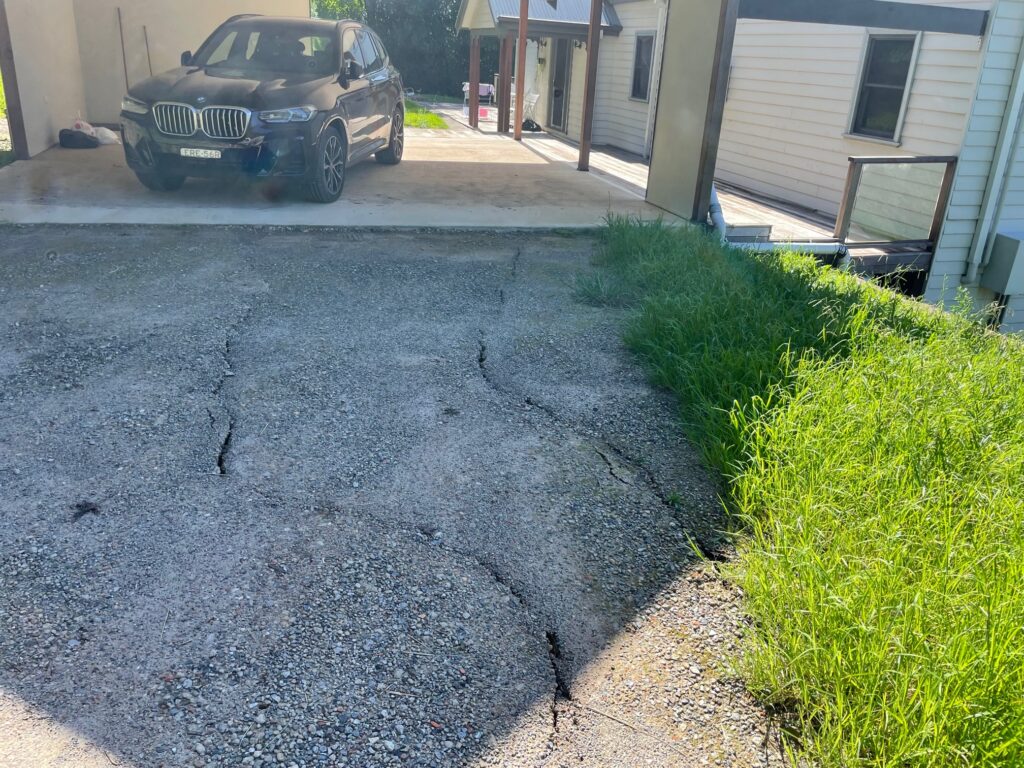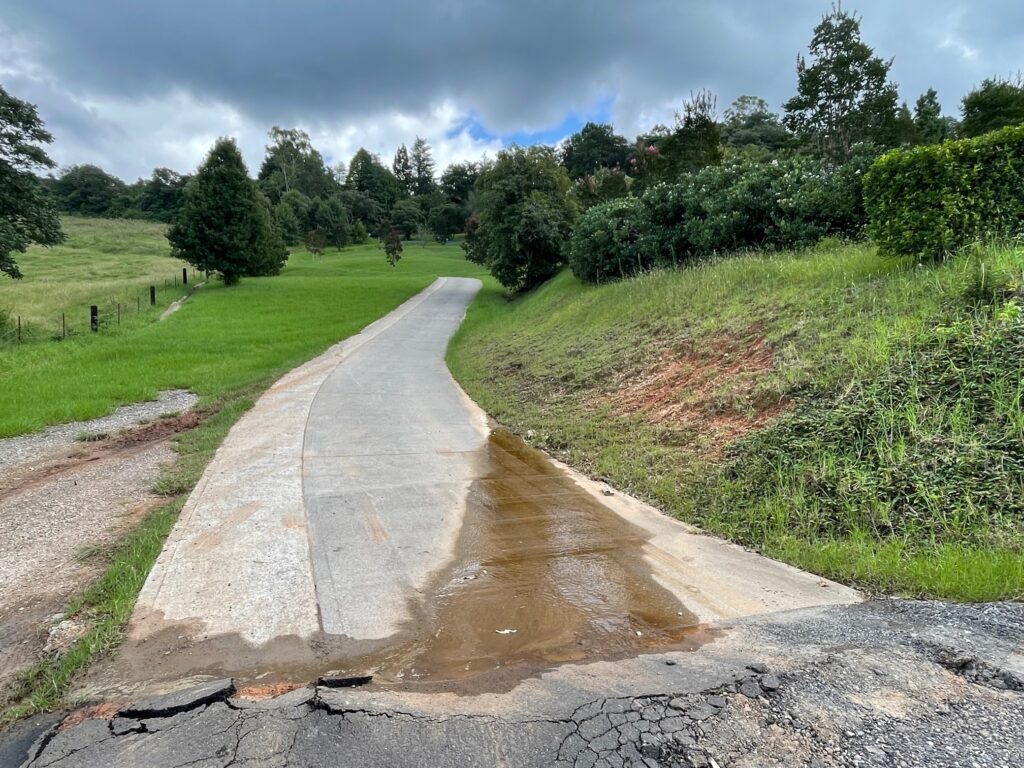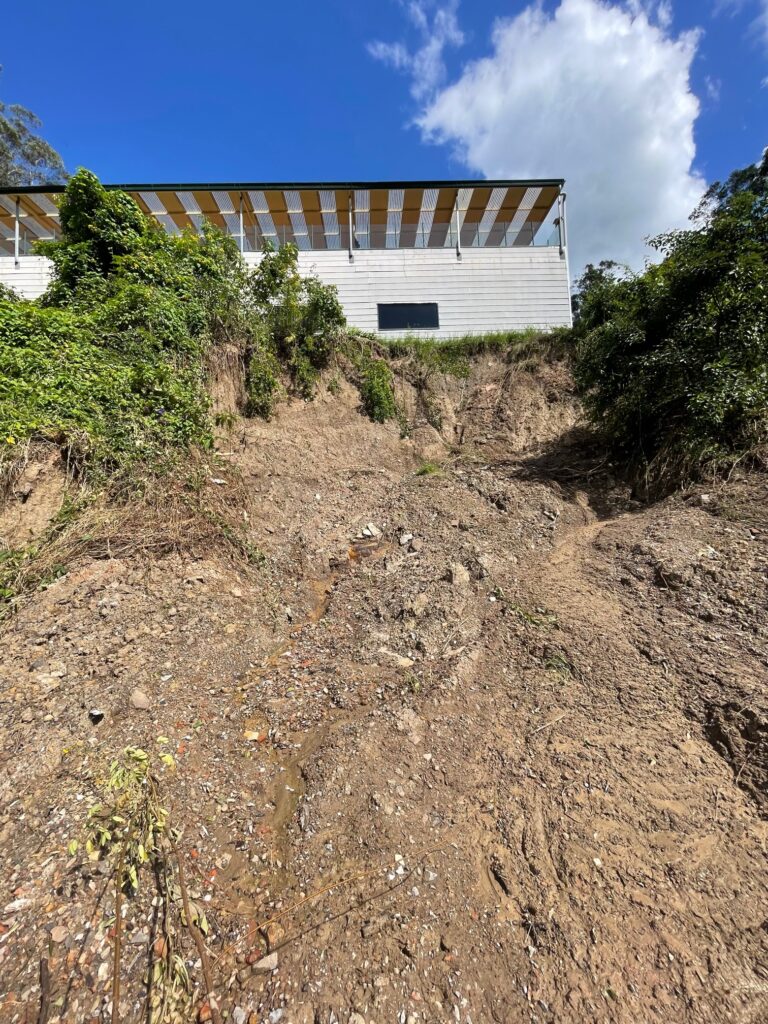
Landslip and Landslide
I’ve been running around madly over last week trying to help people on the west side of the Hawkesbury River who have had a landslip or landslide at their property. The following is general advice for anyone whose property is subject to some sort of movement. It isn’t a substitute for site-specific advice.

Water, Water Everywhere
Overall, I’ve been to about 150 failed retaining walls and earth slips in my career. Without a single exception they’ve all happened during heavy rain.
Water has multiple undesirable effects:
- It adds weight to the soil mass
- It weakens the cohesion of the soil
- Water pressure in the soil pores reduces the contact stresses between the soil at a microscopic level reducing its frictional capacity
- “Hydrostatic” water pressure on retaining walls
- Erosion can trigger a slide
So, if you’ve got land that’s been subject to a landslip, or potentially subject to one, probably the first thing to do is get water off that slope.
There are three fundamentally different sources of water problems:
- Rain that falls directly on the affected land
- Rain that falls uphill and flows over land and onto the slip prone area
- Rain that falls uphill and flows through the subsoil.
Directly Falling Water
For the water that falls directly on the affected land, keeping the ground well vegetated will limit the concentration of water that could cause an erosion which might then trigger a landslip. Collecting the water in surface drains (swales) and getting it off the bank as quickly as possible is the engineering solution.
If the land has already slipped then, in addition to the above, you want to seal surface cracks as they form a direct route for the water into the soil. If it’s still raining, in an emergency you could cover the slip with the slab moisturiser barrier plastic that is available from hardwares to help the sloppy soil stay less-wet.

Uphill Runoff
For water that’s running over the surface from uphill, ideally you should collect it in swales and divert it around the top of the slope to some sort of discharge point. The swales should ideally be constructed or lined with a impermeable clay soil and then should be grassed and maintained in good condition. If there’s actually something like a creek or a gully discharging onto your slope, then some more heavily engineered solution may be in order.

Ground Water
Water running through the ground from uphill is particularly insidious. If you can get that water from uphill diverted elsewhere before it soaks into the soil then all the better. Alternatively, before it gets to your unstable site, construction of deep cut-off trenches lined with geofabric, filled with gravel and sloped to discharge the water away from the unstable land is the engineering solution. This sort of approach needs to be thought through very carefully because the construction of the trench may trigger a slip from above and, if the trench holds water, it may actually concentrate water into the problem area.

Water Disposal
Most of the options I’ve noted above end up with water concentrating at some points away from the vulnerable slope and so you also need to plan how to dispose of that water without causing a problem elsewhere (which could be neighbouring properties). The last thing you want is large amounts of water running transversely across the hillside in swales or trenches and then discharging and running directly down a very steep slope.
Natural Solutions to an Unnatural Problems
Moving on from the issue of water, many landslips are nature’s attempt to address the problems that we humans have created through land clearing, earthmoving, sculpting the landscape, building structures, and building retaining walls where we have loaded up slopes with additional weight which causes instability. We have also modified the flow of water across the landscape (often through engineering works!) concentrating water in places it is not meant to be.
So, whether planning some “development” or trying to stabilise an unstable slope, effectively what nature wants is a shallow, well vegetated slope with mature deep-rooted native trees. It also wants gentle water courses that are filled with rocks and debris and pools that slow the movement of water. There are simply limits to how much modification a landscape can take. Unfortunately, in the recent deluge, some sites have passed those limits.

Engineering Solutions
As well as more “natural” solutions there are fairly intense engineering solutions such as soil nailing, soil reinforcing with geogrids, retaining walls, or even bored concrete piers to pin unstable soil to a strong stable sub-base. Existing structures can be underpinned or stabilised with ground injection.
If you are planning a construction or trying to stabilise a construction in an unstable site, then ideally you should get Geotechnical advice from an engineer who will identify the soil profile and its engineering properties. They may use that to do a formal slip analysis and determine whether a site’s level of stability. They may be able to provide advice on mitigation measures. They can also provide design properties for a structural/civil engineer to design, say a retaining wall, a building or design drainage works. And that’s where Project X comes in.
The Short and Long Term
In the short term we have been helping people in distress make an initial assessment of stability of a slipped site. Now that it has stopped raining, in the short term it is unlikely (but not certain) that if it didn’t slip during the worst of the weather then it won’t slip now. In the long run though there is probably an ongoing issue and, if we get rain like that again (that’s three years running so far), we will see some existing slips get worse and new ones developing.
Deal with the water and get some advice!
Let’s have a chat if you need some help.